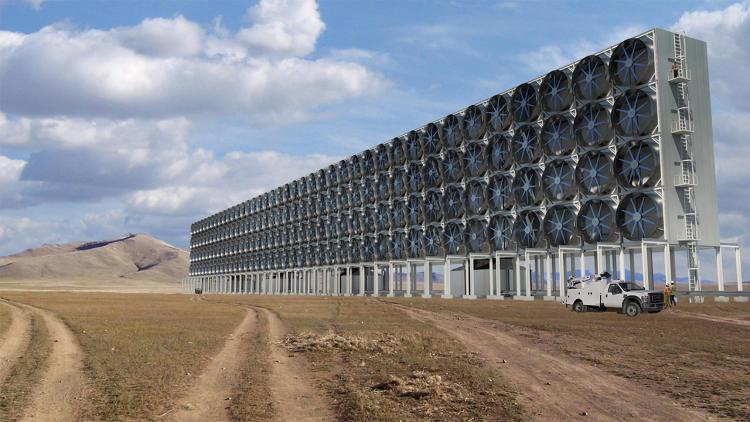SQUAMISH — The air is pure on the coastal road that winds from North Vancouver to Whistler in British Columbia. Midway between the two cities, the village of Squamish sits at the end of a large bay, surrounded by snow-capped mountains. Past the yacht club, a path worms across land belonging to a logging company and the port terminal. The Carbon Engineering headquarters are just before the beach: in under a year, the firm has succeeded in removing a ton of carbon dioxide daily from its surroundings, the equivalent of a round-trip flight from Paris to New York for one passenger.
The world emits more than 90 million tons of carbon dioxide everyday. Carbon Engineering — a small company based in Calgary, Alberta, with funding from Bill Gates, among others — is one of eleven finalists of the Virgin Earth Challenge, which rewards the best greenhouse gas elimination solutions. Chief among the firm's ambitions is to "suck up" a million tons of carbon dioxide annually from the atmosphere by 2020, recycling the gas and producing 400 million tons of synthetic fuel, mainly to be used for heavy transport (planes, trucks, vans...). Carbon Engineering also aims to earn money through the sale of carbon credits.
"Progress is being made"
Of the various emerging measures to combat global warming, this one has the benefit of being easy to set up anywhere, on a large scale and at a reasonable cost, says Geoffroy Holmes, head of development at Carbon Engineering. He notes that "for a long time still, it will be complicated to monitor the origins of greenhouse gas emissions remotely when they don't come from large polluting industries, but from transport, farming..."
With that in mind, he says we might as well capture carbon dioxide in the atmosphere, but without trapping it underground, as existing carbon exploitation units do.
Many scientists are convinced that a mass withdrawal of carbon dioxide from the atmosphere will ultimately be necessary. Carbon Engineering's efforts are "a first step that shows that progress is being made," says Klaus Lackner, the head of the University of Arizona's Center for Negative Carbon Emissions.
Alan Robock, a climatology professor at the University of Rutgers, New Jersey, also views the Canadian project favorably. "It's one of the first attempts at capturing carbon in the atmosphere and using it to make a new product, instead of burying it. I hope such projects will develop on a large scale," he says, noting that he fears high costs will dampen enthusiasm.
Ken Caldeira, an atmosphere expert from the Stanford Carnegie Institution for Science, also wonders about "the commercial viability of this project, which is still in the experimental stage."

Air capture installations are key to the process
In any case, Carbon Engineering has already started recycling captured carbon dioxide to produce synthetic fuel. For now, it only has two rivals — California's Global Thermostat and Switzerland's Climeworks — but the Canadian firm believes it has a technological advantage.
In the trial unit's 7 million-euro yard, the system's key piece takes center stage: The contactor is a box four meters wide, with 2 meters for air intake, and a large fan above. "Its design resembles a cooling tower," explains chemical engineer Kevin Nold.
The similarities end there: instead of hot water, the system uses a sodium or potassium hydroxide solution that absorbs three quarters of the captured carbon dioxide. David Keith, the physics professor at the University of Calgary who created Carbon Engineering, developed the prototype. Now a professor at Harvard, Keith has also earned the title of "environmental hero" from Time magazine for his work on global warming.
The goal: to capture 100,000 tons of carbon dioxide per year
From the contactor, the carbonic gas is transferred to an adjacent warehouse, where it undergoes different chemical reactions. In solid form, it has the shape of beige pellets, like large grains of sand. Every ton of captured carbon dioxide leads to two tons of pellets. The idea is to give the product a tangible value.
"The trial unit has shown that you can capture carbon, and by heating the pellets up to 900°C, through a reaction with hydrogen you can get synthetic fuel," says Holmes.
The company has already gathered 7 million euros in private investments and as much in public funding. At the end of this year, it should be equipped with a synthetic fuel production unit.
"The plan is to produce one barrel per day before rolling out the real commercial phase," Holmes explains. "As early as 2018, we will have a factory for carbon capturing and fuel recycling." The goal is to capture 100,000 tons of carbon dioxide per year and produce 40 million liters of fuel, enough to supply 25,000 vehicles annually. Eventually, scientists hope to multiply those outputs tenfold.
Successful marketing of this technology could bring in 28 million euros per year, at 1 euro per liter of fuel. And that doesn't include income from carbon credit sales. At 84 euros per ton, 100,000 tons of carbon dioxide taken out of the atmosphere would bring in 8.4 million euros.
"Eventually, we will be able to capture ten times more carbon dioxide with a single unit," says Holmes. "Imagine if we start setting them up worldwide."





